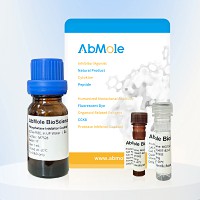All AbMole products are for research use only, cannot be used for human consumption.

Tat-NR2B9c is a 20-aa peptide, it acts as a postsynaptic density-95 (PSD-95) inhibitor with EC50 of 6.7 nM for PSD-95d2. Tat-NR2B9c also reduces NMDA-induced p38 activation, and possesses neuroprotective efficacy. Tat-NR2B9c inhibits NMDAR2A, NMDAR2B, and NMDAR2C binding to PSD-95, with IC50s of 0.5 μM, ∼8 μM, and 0.75 μM, respectively. Tat-NR2B9c also blocks the interaction between PSD-95 and nNOS with an IC50 of ∼0.2 μM. In male C57BL/6 mice, Tat-NR2B9c (10 nM/g; i.v.) reduces infarction volume , but has no effect at 3 nM/g.
| Cell Experiment | |
|---|---|
| Cell lines | Postnatal mono-cultured WT and YAC128 striatal neurons |
| Preparation method | Postnatal mono-cultured WT and YAC128 striatal neurons are pretreated for 1 h with 200 nM Tat-NR2B9c, and/or SB-239063 (p38 inhibitor), and/or SP-600125 (JNK inhibitor), then incubated with or without 500 μM NMDA for 10 min. After NMDA treatment, striatal neurons are washed once with warm plating medium (PM) and then incubated in conditioned PM (without Tat peptides or p38, JNK inhibitors) for 24 h. Then cells are washed with PBS once and fixed with 4% paraformaldehyde (PFA) for 30 min. |
| Concentrations | 200 nM |
| Incubation time | 1 h |
| Animal Experiment | |
|---|---|
| Animal models | Mice |
| Formulation | - |
| Dosages | 0.0, 3.0, 10.0 nMole/g |
| Administration | intravenously via the tail vein using a pump in a volume of 1 µL/g |
| Molecular Weight | 2518.88 |
| Formula | C105H188N42O30 |
| CAS Number | 500992-11-0 |
| Solubility (25°C) | Water 30 mg/mL |
| Storage | -20°C, sealed |
| Related Peptides Products |
|---|
| TMTP1 Peptide
TMTP1 is a 5-amino acid peptide NVVRQ, it can be used for the labeling of malignant in situ and metastatic lesions, and even micro-metastases. TMTP1 specifically bound to the cells of a series of hematological malignancies, including HL60, k562, Jurkat, Raji, El-4 and chronic myeloid leukemia primary cells but not to bone marrow mononuclear cells from healthy subjects. TMTP1, as a novel tumor-homing peptide, can serve as a marker for primary malignant and metastatic lesions. |
| Amylin amide, human TFA
Amylin amide, human TFA is a 37-amino acid polypeptide, it is a pancreatic hormone cosecreted with insulin that exerts unique roles in metabolism and glucose homeostasis. Amylin amide, human TFA inhibits glucagon secretion, delays gastric emptying. |
| WL47 TFA
WL47 TFA, a high-affinity cavolin-1 (CAV1) ligand (Kd=23 nM), is a potent disrupter of CAV1 oligomers. WL47 TFA shows selectivity for CAV1 over BSA, casein and HEWL. WL47 TFA can be used for the study of caveolin-1 function. |
| Angiopep-2-Cys TFA
Angiopep-2-cys is a conjugate of Angiopep-2 hydrochloride and cysteine. The conjugation of anticancer agents with the Angiopep-2 peptide vector could increase their efficacy in the treatment of brain cancer. |
| H3K4(Me2) (1-20)
H3K4(Me2) (1-20) is a histone peptide. H3K4me2 regulates the recovery of protein biosynthesis and homeostasis following DNA damage. |
All AbMole products are for research use only, cannot be used for human consumption or veterinary use. We do not provide products or services to individuals. Please comply with the intended use and do not use AbMole products for any other purpose.


Products are for research use only. Not for human use. We do not sell to patients.
© Copyright 2010-2024 AbMole BioScience. All Rights Reserved.
